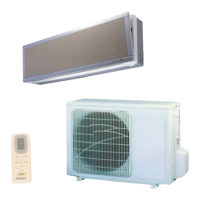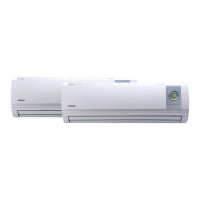Air purging and leakage test
1.Remove the flare nuts from the cut - off valves of the outdoor
unit.
2.Align the center of the piping flare with the relevant valve, and
screw in the flare nut about 3~4 turns by hand.
3.Tighten the flare nut with spanner and torque wrench.
4.Remove the valve caps of the gas valve and liquid valve and
the service port nut.
5.Loosen the valve stem of the liquid valve with a hex wrench.
6.Push the check valve core of the gas valve to discharge air and
moisture remaining in the refrigerant system.
7.Stop pushing the valve core as soon as the refrigerant starts to
be discharged, and reinstall the service port nut.
8.Open the liquid valve and gas valve entirely (shown in Fig.9).
9.Tighten the valve caps and test leakage at all joints of the pip-
ing (both indoor and outdoor) with liquid soap or leak detector.
10.If possible, discharge air and moisture remaining in the re-
frigerant system with a vacuum pump. (shown in Fig.10)
11.*CAUTION: If there is no exhaust or the exhaust capacity is
not enough, please make sure all wires are connected correctly
first, then electrify the outdoor main power (“L” “N”) (no need
to power on ) for tens of seconds. When the corresponding
electric expansion valve opens, exhaust again.
Outdoor condensation drainage
(Heat pump type only)
When the unit is heating or defrosting,the waste
water formed in the outdoor unit can be drained out
reliably through the drain hose.
Installation:
Install the outdoor drain elbow in the 25 hole on
the base plate as shown in Fig.11, and joint the drain
hose to the elbow, so that the waste water formed in
the outdoor unit can be drained out to a proper place.
HOW TO INSTALL THE OUTDOOR UNIT
29

